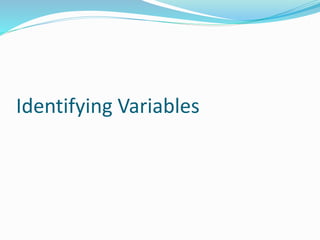Identify variables
•Download as PPTX, PDF•
0 likes•292 views
Research Methodology Identifying Variables
Report
Share
Report
Share

Recommended
Recommended
More Related Content
What's hot
What's hot (20)
Validity, reliability & Internal validity in Researches

Validity, reliability & Internal validity in Researches
Similar to Identify variables
Similar to Identify variables (20)
typesofvariablesinresearchankitach-181022084515.docx

typesofvariablesinresearchankitach-181022084515.docx
TYPES OF VARIABLES ACCORDING TO CLASSIFICATION.pdf

TYPES OF VARIABLES ACCORDING TO CLASSIFICATION.pdf
More from Laiba Yaseen
More from Laiba Yaseen (20)
Phonological and Phonetic Features of Pakistani English

Phonological and Phonetic Features of Pakistani English
Recently uploaded
Recently uploaded (20)
Unit-IV; Professional Sales Representative (PSR).pptx

Unit-IV; Professional Sales Representative (PSR).pptx
Python Notes for mca i year students osmania university.docx

Python Notes for mca i year students osmania university.docx
Fostering Friendships - Enhancing Social Bonds in the Classroom

Fostering Friendships - Enhancing Social Bonds in the Classroom
General Principles of Intellectual Property: Concepts of Intellectual Proper...

General Principles of Intellectual Property: Concepts of Intellectual Proper...
This PowerPoint helps students to consider the concept of infinity.

This PowerPoint helps students to consider the concept of infinity.
Vishram Singh - Textbook of Anatomy Upper Limb and Thorax.. Volume 1 (1).pdf

Vishram Singh - Textbook of Anatomy Upper Limb and Thorax.. Volume 1 (1).pdf
Micro-Scholarship, What it is, How can it help me.pdf

Micro-Scholarship, What it is, How can it help me.pdf
ICT Role in 21st Century Education & its Challenges.pptx

ICT Role in 21st Century Education & its Challenges.pptx
Kodo Millet PPT made by Ghanshyam bairwa college of Agriculture kumher bhara...

Kodo Millet PPT made by Ghanshyam bairwa college of Agriculture kumher bhara...
On National Teacher Day, meet the 2024-25 Kenan Fellows

On National Teacher Day, meet the 2024-25 Kenan Fellows
Identify variables
- 2. Identify Variables What is variable? An image, perception or concept which can be measured on different values is call variable. “Kerlinger” said, A variable is a property that takes on different value is called variable. e.g , If we take an example of “Food” some say delicious, excellent another say sour, awful, one’s say I like it so much and one’s say I do not like this so these are the values of variable which can be vary from person to person.
- 3. Different between Concept and a Variable The main difference between them is measurability. Concepts are mental images, perceptions which can’t be measured. Variable are measurable which are measured on different values. It is important for the concept to be converted into variable.
- 4. Concepts Variables Effectiveness Gender( male/female) Satisfaction Attitude Impact Age Excellent Income High achiever Weight Self-esteem Height Domestic Violence Religion
- 5. Types of Variable A variable can be classified in a number of ways. The classification of variables in three different ways. the casual relationship the study design the unit of measurement
- 6. From the view point of casual relationship To investigate a casual relationship or association, four sets of variables may operate. 1. Indepentent variable - Change variables, which are responsible for bringing about change in a phenomenon, situation or circumstances. 2. Depent variable - outcome variables, which are the effects, impacts or consequences of a change variable.
- 7. conti.... 3. Extraneous variable - variables which affect or influences the link between cause-and-effect variables. 4. Interventing variables - connecting or linking variables, which in certain situation are necessary to complete the relationship between cause-and-effect variables.
- 8. From the view point of the unit of measurement From the viewpoint of the unit of measurement, there are two ways of categorising variables. 1. Categorical variables - are measured on nominal or ordinal measurement scales whereas, 2. Continuous variables - the measurement are made on either an interval or ratio scale.
- 9. conti.... There are three types of categorical variables: a. Constant variable - has only one category or value, For example taxi, tree and water. b. Dichotomous variable - has only two categories, as in male/female, yes/no, good/bad, head/tail, up/down, rich/poor. c. Polytomous variable - can be divided into more than two categories, For example Religion (Christian, Muslims, Hindu); political parties (Labore, Liberal, Democrat) and attitudes (SF, F, N, UF, SUF).
- 10. Types of Measurement Scale: The frame, into which we wish to make everything fit is one of our own construction; but we don’t construct it at random, we construct it by measurement so to speak. Types: The Nominal or Classificatory Scale The Ordinal or Ranking Scale The Interval Scale The Ratio Scale
- 11. The Nominal or Classificatory Scale: A nominal scale enables the classification of individuals, objects or responses based on a common/shared property or characteristic. A variable measured on a nominal scale may have one, two or more subcategories depending upon the extent of variation. For example: ‘’Water’’ and ‘’Taxi’’ have only one subgroup, whereas the variable ‘’gender’’ can be classified into two subcategories: male and female. The Ordinal or Ranking Scale: An ordinal scale has all the properties of a nominal scale-categorising individuals , objects, responses or a property into sub groups on the basis of a common characteristic- but also ranks the subgroups in a certain order. For example: Income can be measured either quantitatively (in dollars and cents ) or qualitatively, using subcategories: ‘above average’, ‘average’ and ‘below average’.
- 12. The interval scale: An interval scale has all the characteristics of an ordinal scale; that is, individuals or responses belonging to a subcategory have a common characteristic and the subcategories are arranged in an ascending or descending order. For example: Celsius and Fahrenheit scales are examples of an interval scale. The ratio scale: A ratio scale has all the properties of nominal, ordinal and interval scales and it also has a starting point fixed at zero. Therefore, it is an absolute scale –the difference between intervals is always measured from a zero point. This means the ratio scale can be used for mathematical operations. For example: The measurement of income, age, height and weight are examples of this scale.
